PRINCETON, NJ -- Gallup Poll Daily tracking for the week after Easter (Monday, April 13 through Sunday, April 19) finds the consumer mood continuing its positive surge, supported by a weekly improvement in job-market conditions but not yet producing a concomitant improvement in consumer spending.
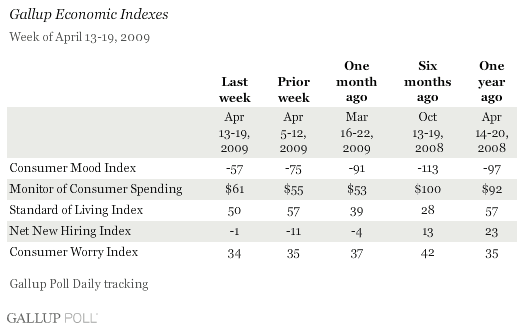
(Maximum possible value of 200; minimum possible value of -200)
The Gallup Consumer Mood Index improved significantly to -57 for the week ending April 19, much better than the -75 of the prior two weeks. The Index is much improved from -91 just a month ago and far surpasses the -97 of a year ago. The weekly Index is now tied for its second-highest level since daily tracking of the consumer mood began in January 2008.

The Consumer Mood Index is based on Americans' answers to two questions -- one asking about current economic conditions in the country and the other about the direction of the economy. Consumers' negativity has diminished significantly on both dimensions compared with early March; however, this has been most pronounced with respect to the direction of the economy.
Consumer perceptions that the economy is getting worse rather than better moderated from a net -59 in early March to a net -29 for the week ending April 12. This past week, the figure moderated even further, to -19.
Consumer perceptions of current economic conditions remain much more negative than positive, with 11% calling them "excellent" or "good" versus 49% calling them "poor," resulting in a net current conditions score of -38. Still, this is an improvement from the -46 of the week ending April 12 and the -45 of the prior two weeks.
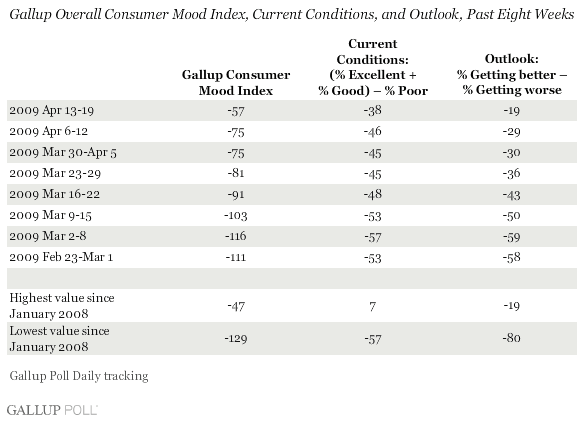
(Unlimited maximum possible value; minimum possible value of $0)
Americans last week reported spending an average of $61 per day in stores, restaurants, gas stations, and online. This is up from $55 in average daily spending the week prior but down 40% from the $92 average daily spending a year ago. Spending for the week ending April 12 was also down, by 29% from the same week in 2008. Adjusting for seasonal effects by using year-ago comparables suggests consumer spending has yet to respond to the sharp improvement taking place in the consumer mood. (Gallup's spending data are based on Americans' self-reports of the total amount of money they spent the prior day on purchases other than a home, a motor vehicle, or their normal monthly bills.)
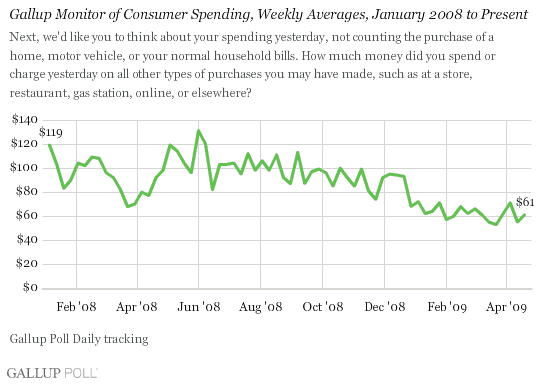
(Maximum possible value of 100; minimum possible value of -100)
Potentially reinforcing the sustained surge in the consumer mood of the past five weeks, employees' reports on hiring and firing patterns at their own workplaces showed major improvement in the most recent week. The Gallup Net New Hiring Index for the week ending April 19 was at -1, up from the -11 of the previous week, and even better than the -4 of a month ago.
Net New Hiring was in positive territory for most of 2008, descending below zero for the first time in mid-December. It has been in negative territory throughout 2009 thus far, and the -11 for the week ending April 12 is the lowest reading since tracking began in January 2008.
The Gallup Net New Hiring Index for last week is based on the finding that 25% of full- and part-time workers said their employers were hiring people and expanding the number of employees in their workforces, while 26% reported their companies were letting people go and shrinking the size of their workforces.
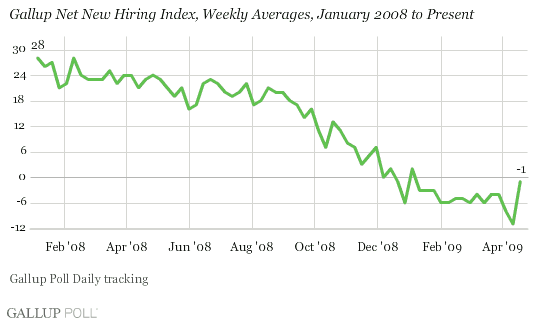
(Maximum possible value of 200; minimum possible value of -200)
The Gallup Standard of Living Index bounced back down in the past week to 50, after surging to 57 in the prior week. Still, the Index is significantly higher than it was a month ago (39), and not far from the 57 of a year ago.
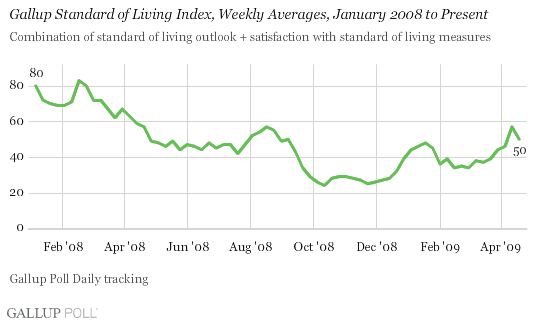
The Standard of Living Index is based on two questions -- one asking about respondents' satisfaction with their current standard of living and the other about the perceived direction of their standard of living. This past week, marginally more consumers said their standard of living is getting better (40%) than said it is getting worse (37%). At the same time, 73% of consumers said they are satisfied with their standard of living -- down slightly from 75% last week.
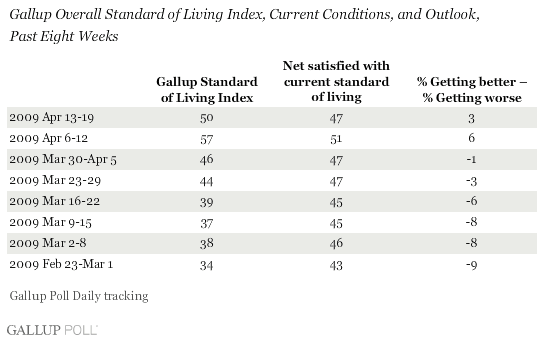
(Maximum possible value of 100; minimum possible value of 0)
The Gallup Consumer Worry Index is at 34 for the week ending April 19 -- essentially the same as the readings for the previous two weeks and for a year ago.

Commentary
The consumer mood continues to show sharp improvement. An Easter "halo effect" may have played some role in perceptions of the economy in the most recent week, but the improving trend in the consumer outlook for the future direction of the economy is quite pronounced. And, even consumer ratings of current economic conditions have improved in recent weeks.
Still, the most positive aspect of last week's results has to do with the sharp improvement in job-market perceptions. These perceptions -- like the jobless claims data they tend to project -- may have been skewed by the Easter holiday, as was the case during Christmas. However, a real improvement in the jobs outlook would go a long way toward indicating that the current economic downturn is finally bottoming out.
On the other hand, the failure of consumer spending to improve over the past several weeks even as the consumer mood has greatly improved suggests consumers have yet to feel comfortable enough with their household balance sheets and their income and employment situations to return to their day-to-day spending of a year ago. And, this would be just the first step for consumers prior to becoming willing once more to purchase a big-ticket item like a car or truck.
Until the decline in consumer spending comes to a halt, businesses will have to continue to operate in survival mood. In turn, this suggests that no one should assume that the economic downturn has leveled off -- let alone that a recovery has begun -- as the stress of a more traditional plunge in economic activity continues to take its toll on the nation's businesses and the people they employ.
Survey Methods
For Gallup Poll Daily tracking, Gallup interviews approximately 1,000 national adults, aged 18 and older, each day. Gallup's consumer series includes the Gallup Consumer Mood Index (evaluating public perceptions about the U.S. economy), the Gallup Monitor of Consumer Spending (a measure of how much money Americans are spending each day on mainly retail purchases), the Gallup Net New Hiring Index (a measure of employee perceptions of hiring conditions where they work), the Gallup Standard of Living Index (evaluating the public's perceptions about its own standard of living), and the Gallup Consumer Worry Index (a measure of the degree to which Americans are worried about their finances).
The Standard of Living Index is based on questions asked of all respondents; the Gallup Consumer Mood Index, the Gallup Monitor of Consumer Spending, and the Gallup Consumer Worry Index are based on random half-samples of approximately 500 national adults, aged 18 and older, each day. The Gallup Net New Hiring Index is based on a sample of approximately 250 current full- and part-time employees each day.
The sample sizes and associated margins of error for weekly results for the week of April 13-19 are:
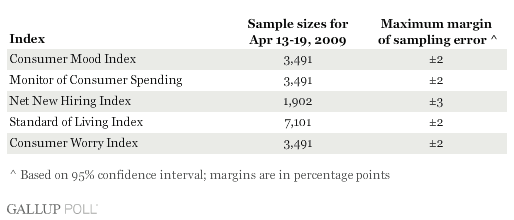
Interviews are conducted with respondents on land-line telephones (for respondents with a land-line telephone) and cellular phones (for respondents who are cell-phone only).
In addition to sampling error, question wording and practical difficulties in conducting surveys can introduce error or bias into the findings of public opinion polls.
